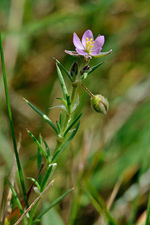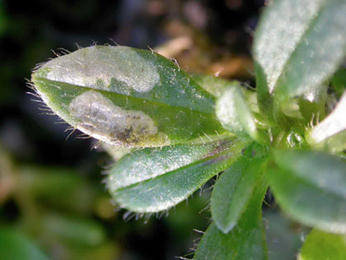|
||||||
SPERGULARIA. Sea-spurreys. [Caryophyllaceae] |
|
Eight species of Spergularia are recorded in Britain. These include the native Greek Sea-spurrey (S. bocconei); Lesser Sea-spurrey (S. marina), Greater Sea-spurrey (S. media), Sand Spurrey (S. rubra) and Rock Sea-spurrey (S. rupicola). The BSBI provide a downloadable plant crib for Spergularia bocconei vs Spergularia rubra and Spergularia marina vs x rupicola. Six British miners are recorded on Spergularia. A key to the European miners recorded on Spergularia is provided in Bladmineerders van Europa. |
 Sand Spurrey Spergularia rubra |
Key for the identification of the known mines of British |
||||||||||||||||||||||||
1a > Leaf-miner: Leaf and stem miner: Eggs are scattered individually over the leaf upper surface; they are only loosely attached to the plant. The egg shell has a honeycomb structure. The larva begins with first mining one of the top leaves completely out. Next the larva moves down to another leaf, by way of a tunnel made in the stem. In this way several leaves are mined out, completely and full depth. In the attacked part of the plant the stem has become translucent; the damage causes the plant tip to wilt. In the first mines almost no frass is to be found, further down it is deposited in coarse grains. Pupation generally outside the mine (Miles, 1953). |
||||||||||||||||||||||||
|
||||||||||||||||||||||||
|
Delia echinata (Seguy, 1923) [Diptera: Anthomyiidae]. |
||||||||||||||||||||||||
1b > Leaf-miner: A short, irregular, linear upper surface mine on any part of the leaf. Also recorded from young pods (Bland, 1997a). Long corridor mine. As a rule the first part of the mine is lower-surface, the later part upper-surface. Often the loops are so dense that a secondary blotch is the result. Because upper- and lower-surface corridor segments often cross, the mine obtains a strange array of transparant patches. There is no association with the midrib. Frass in strings and thread fragments. Pupation outside the mine; exit slit in upper epidermis. Mine not associated with the veins or midrib of the leaf (It is this character which enables distinction from another Agromyzid pest species - Liriomyza huidobriensis). The larvae may leave one leaf (if not large enough) and enter another leaf, via the petiole). It exits the leaf to pupate through a semi-circular slit in the upper surface of the leaf. |
||||||||||||||||||||||||
|
||||||||||||||||||||||||
Liriomyza bryoniae (Kaltenbach, 1858) [Diptera: Agromyzidae]. |
||||||||||||||||||||||||
1c > Leaf-miner: A distinctive mine primarily above mid-rib, with irregular short lateral offshoots into leaf blade. Pupation external (Spencer, 1972: 51 (fig. 172), 55; Spencer, 1976: 270, 271 (fig. 486)). Branched, whitish, upper-surface corridor; main axis overlying the midrib; side branches overlying the main lateral veins. (In Campanula and Phyteuma the mine is much less branched, sometimes nothing more than a corridor on top of the midrib). Frass in rather long strings. Usually the mines begins as a long and narrow, shallow, tortuous lower-surface corridor that ends upon the midrib but otherwise is not associated with the leaf venation. Often this initial corridor is filled with callus, and then even less conspicuous. Pupation outside the mine. A linear mine on the upper surface, usually following the midrib and showing side branches along the veins. The frass is in strings. |
||||||||||||||||||||||||
|
||||||||||||||||||||||||


